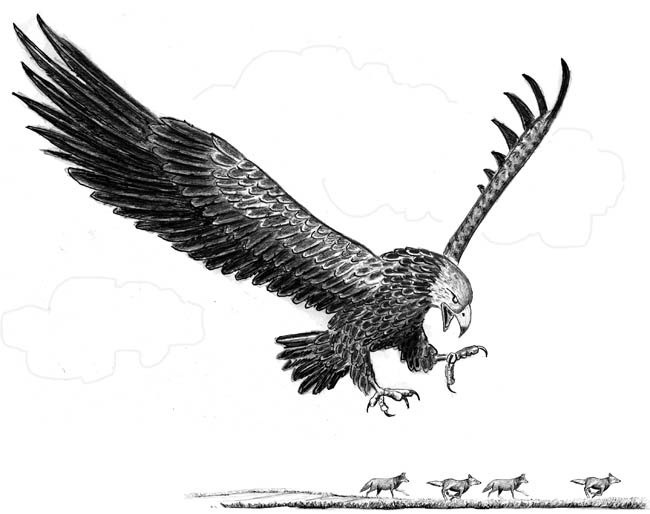
Dear Bird Folks,
I was reading a story online about South America’s Harpy Eagle, which some claim is the world’s largest bird of prey. But the article also mentioned a much larger bird called a “Mammoth Eagle,” that sometimes can be seen on Cape Cod. However, I have found very little statistical info about the bird’s size and weight, and when it can be seen on the Cape. What do you know about the Mammoth Eagle?
– Charles, Sandwich, MA
You are good, Charles,
You are good at finding secrets. The Mammoth Eagle project is supposed to be on the QT. Few people know about it, which is why so little statistical info is posted. But now that you know, I guess I can’t get into trouble by writing about it; just promise to visit me if I end up in jail. Prison can be a difficult place for a vegetarian bird watcher.
The reason you didn’t find much about the Mammoth Eagle is because the bird didn’t exist until fifteen years ago. For centuries Western cattle ranchers have been fighting a losing battle with coyotes. To control them ranchers have tried shooting, trapping and even poisoning coyotes, but with little success. To make things worse, coyotes have no serious natural enemies, except for the occasional rattlesnake, lightning strike or backfire from a defective rocket (Wile E. Coyote only). That began to change in 1993 when a rancher came up with the idea of creating a natural coyote enemy. With funds provided by the Cattle Ranchers Association, a crossbreeding eagle program was planned. (This should not be confused with cross-dressing eagles. That’s a different program altogether.) However, the project was almost cancelled because U.S. law prohibits crossbreeding native wildlife. Then somebody thought of our neighbors to the south. Good old Mexico, and its less restrictive animal breeding laws, was just the country the cattle ranchers were looking for. The project was back on.
For five years researchers at the Dia de los Inecentes Ranch, just outside of La Paz, worked to produce a bird large enough to capture coyotes. At first it was slow going, then they hit the jackpot…big time. By crossbreeding South America’s giant Harpy Eagle (the one you mentioned earlier) with North America’s largest raptor, the Golden Eagle, and doing some genetic tweaking, researchers were able to produce a super eagle. In 1998, scientists at the Dia de los Inecentes Ranch produced the largest known flying bird since the days of the Giant Teratorn (which went extinct six million years ago). Thrilled by their success, researchers quickly went about producing many more of these huge birds. They also changed the bird’s code name from “AFD 4-1,” to the more pronounceable Mammoth Eagle.
When fully grown, Mammoth Eagles have a wingspan of over twenty feet and weigh up to seventy-five pounds. With their nine-inch talons they can easily capture and fly away with the West’s largest coyote. But there was a problem. As soon as the Interior Department got wind of this eagle they filed suit to prevent its release. The feds claimed the bird is non-native and would become an invasive species. But lawyers for the cattle ranchers argued, correctly, that the new bird is a hybrid (like a mule, not a Prius) and thus cannot reproduce on its own and, therefore, can never become invasive. A Texas judge agreed with the Cattle Ranchers Association (surprise!) and the suit was dropped, setting the stage for the project’s last step.
During the winter of 2004, fifty-eight Mammoth Eagles were released at various sites in Texas, Oklahoma and Nebraska. The cattle ranchers held their collective breaths, waiting to see if their five-year, seven million dollar project would produce the desired results. They didn’t have to wait long. The genetically modified giant eagles locked onto the coyotes like lasers. In the first year the western coyote numbers were reduced by five percent. And in the ten years since, the once out-of-control coyote population has been reduced by nearly twenty percent. The ranchers are so thrilled with the results that they have put away their poison, traps and guns. (Well, probably not their guns. Remember, we are talking about Texas.)
Fast forward to June 2013, when a group of concerned Cape citizens approached the creators of AFD 4-1 about purchasing some of the jumbo predators to help deal with the Cape’s burgeoning coyote population. Even though most locals have learned to appreciate coyotes, there continues to be one group that has been obsessed with totally eradicating coyotes on Cape Cod. Through private fund-raising the group secured the $20,000 needed to buy four of these massive birds and have them transported to the Cape. Next the group needed a place to release the birds. After careful consideration, it appears the site chosen is Harwich’s Thompson’s Field Conservation Area. It’s been announced that this Tuesday at 11:00 AM, a spectacular Mammoth Eagle demonstration and release event will take place, with coverage provided by TV’s Discovery Channel. Bring your camera.
Birders from all over are excited about seeing the Mammoth Eagles, but I can’t help wondering if releasing them to fly freely over Cape Cod is a bad idea. Isn’t this anti-coyote group being a little shortsighted? If these huge predators can carry adult coyotes away, what might they do to people’s pets? I guess we’ll find out soon enough. The release will be at Harwich’s Thompson’s Field Conservation Area at 11:00 AM, this Tuesday, April 1st.